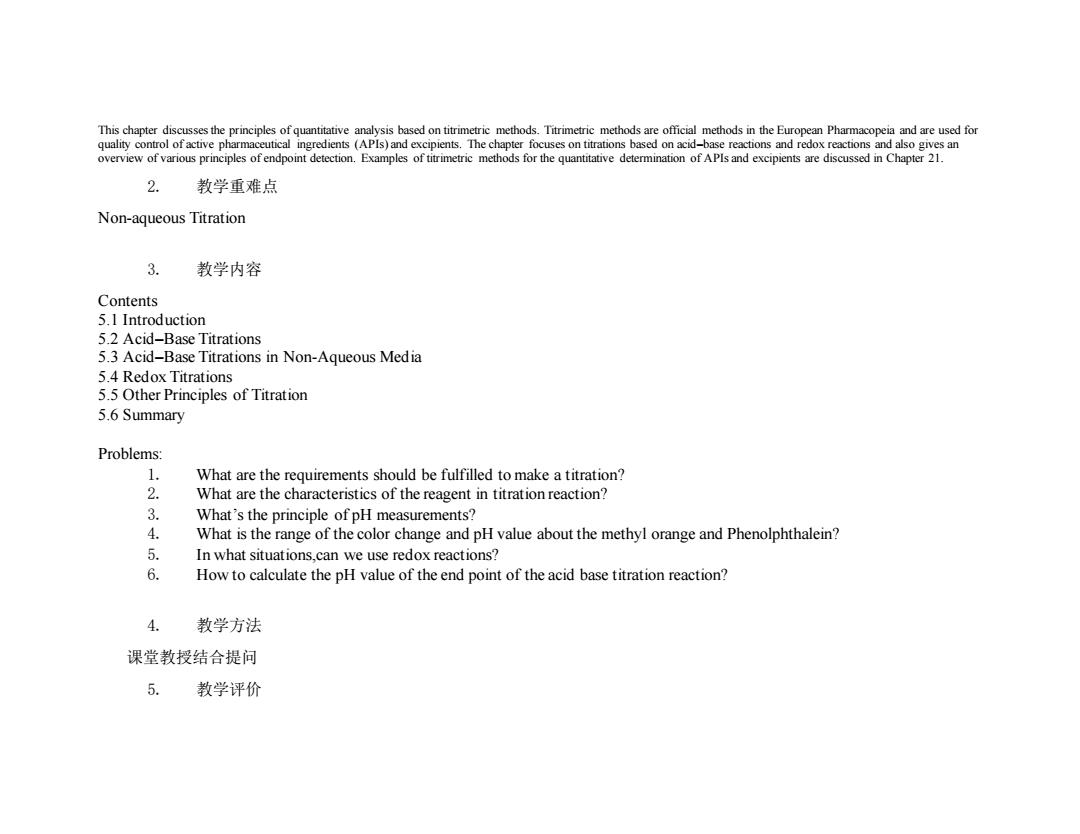
This chapter discusses the principles of quantitative analysis based on titrimetric methods.Titrimetric methods are official methods in the European Pharmacopeia and are used for quality control of active pharmaceutical ingredients (APIs)and excipients.The chapter focuses on titrations based on acid-base reactions and redox reactions and also gives an overview of various principles of endpoint detection.Examples of titrimetric methods for the quantitative determination of APIs and excipients are discussed in Chapter 21. 2. 教学重难点 Non-aqueous Titration 3. 教学内容 Contents 5.1 Introduction 5.2 Acid-Base Titrations 5.3 Acid-Base Titrations in Non-Aqueous Media 5.4 Redox Titrations 5.5 Other Principles of Titration 5.6 Summary Problems: 1. What are the requirements should be fulfilled to make a titration? 2. What are the characteristics of the reagent in titration reaction? 3. What's the principle of pH measurements? 4. What is the range of the color change and pH value about the methyl orange and Phenolphthalein? 5. In what situations,can we use redox reactions? 6. How to calculate the pH value of the end point of the acid base titration reaction? 4. 教学方法 课堂教授结合提问 5. 教学评价
This chapter discusses the principles of quantitative analysis based on titrimetric methods. Titrimetric methods are official methods in the European Pharmacopeia and are used for quality control of active pharmaceutical ingredients (APIs) and excipients. The chapter focuses on titrations based on acid–base reactions and redox reactions and also gives an overview of various principles of endpoint detection. Examples of titrimetric methods for the quantitative determination of APIs and excipients are discussed in Chapter 21. 2. 教学重难点 Non-aqueous Titration 3. 教学内容 Contents 5.1 Introduction 5.2 Acid–Base Titrations 5.3 Acid–Base Titrations in Non-Aqueous Media 5.4 Redox Titrations 5.5 Other Principles of Titration 5.6 Summary Problems: 1. What are the requirements should be fulfilled to make a titration? 2. What are the characteristics of the reagent in titration reaction? 3. What’s the principle of pH measurements? 4. What is the range of the color change and pH value about the methyl orange and Phenolphthalein? 5. In what situations,can we use redox reactions? 6. How to calculate the pH value of the end point of the acid base titration reaction? 4. 教学方法 课堂教授结合提问 5. 教学评价
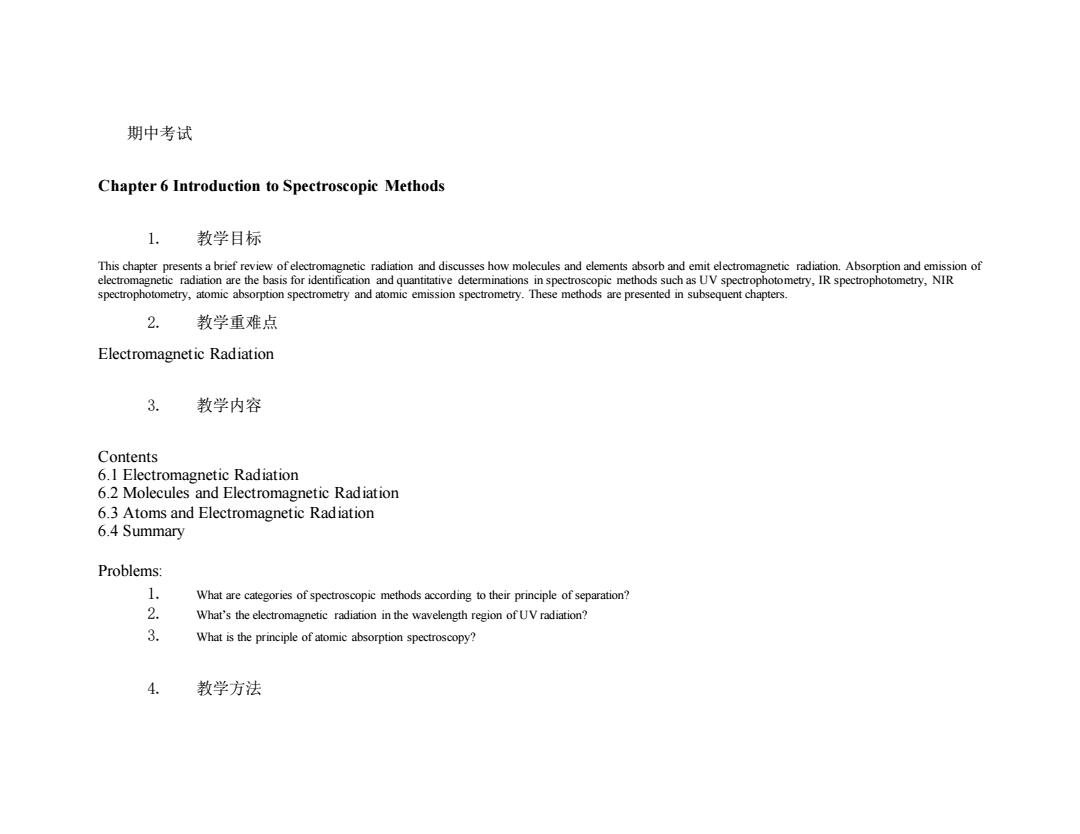
期中考试 Chapter 6 Introduction to Spectroscopic Methods 1. 教学目标 This chapter presents a brief review of electromagnetic radiation and discusses how molecules and elements absorb and emit electromagnetic radiation.Absorption and emission of electromagnetic radiation are the basis for identification and quantitative determinations in spectroscopic methods such as UV spectrophotometry,IR spectrophotometry,NIR spectrophotometry,atomic absorption spectrometry and atomic emission spectrometry.These methods are presented in subsequent chapters. 2. 教学重难点 Electromagnetic Radiation 3. 教学内容 Contents 6.1 Electromagnetic Radiation 6.2 Molecules and Electromagnetic Radiation 6.3 Atoms and Electromagnetic Radiation 6.4 Summary Problems: 1. What are categories of spectroscopic methods according to their principle of separation? 2. What's the electromagnetic radiation in the wavelength region of UV radiation? 3. What is the principle of atomic absorption spectroscopy? 4. 教学方法
期中考试 Chapter 6 Introduction to Spectroscopic Methods 1. 教学目标 This chapter presents a brief review of electromagnetic radiation and discusses how molecules and elements absorb and emit electromagnetic radiation. Absorption and emission of electromagnetic radiation are the basis for identification and quantitative determinations in spectroscopic methods such as UV spectrophotometry, IR spectrophotometry, NIR spectrophotometry, atomic absorption spectrometry and atomic emission spectrometry. These methods are presented in subsequent chapters. 2. 教学重难点 Electromagnetic Radiation 3. 教学内容 Contents 6.1 Electromagnetic Radiation 6.2 Molecules and Electromagnetic Radiation 6.3 Atoms and Electromagnetic Radiation 6.4 Summary Problems: 1. What are categories of spectroscopic methods according to their principle of separation? 2. What’s the electromagnetic radiation in the wavelength region of UV radiation? 3. What is the principle of atomic absorption spectroscopy? 4. 教学方法
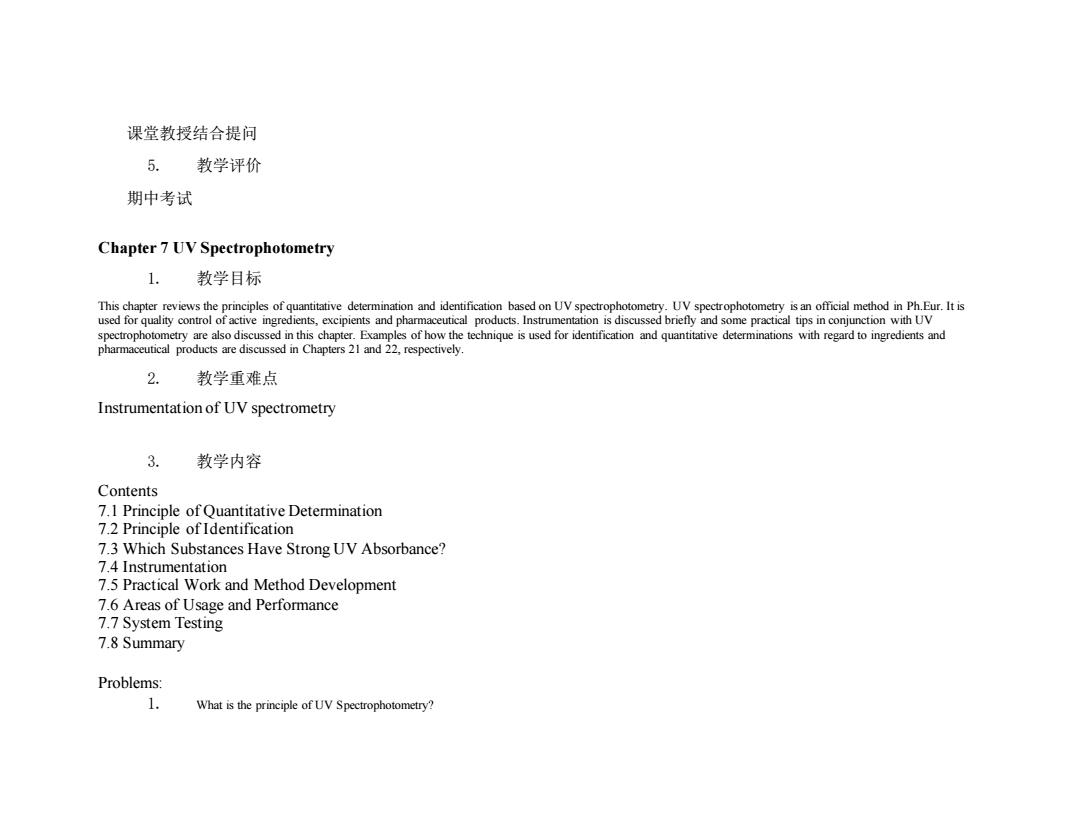
课堂教授结合提问 5. 教学评价 期中考试 Chapter 7 UV Spectrophotometry 1. 教学目标 This chapter reviews the principles of quantitative determination and identification based on UV spectrophotometry.UV spectrophotometry is an official method in Ph.Eur.It is used for quality control of active ingredients,excipients and pharmaceutical products.Instrumentation is discussed briefly and some practical tips in conjunction with UV spectrophotometry are also discussed in this chapter.Examples of how the technique is used for identification and quantitative determinations with regard to ingredients and pharmaceutical products are discussed in Chapters 21 and 22,respectively. 2. 教学重难点 Instrumentation of UV spectrometry 3. 教学内容 Contents 7.1 Principle of Quantitative Determination 7.2 Principle of Identification 7.3 Which Substances Have Strong UV Absorbance? 7.4 Instrumentation 7.5 Practical Work and Method Development 7.6 Areas of Usage and Performance 7.7 System Testing 7.8 Summary Problems: 1. What is the principle of UV Spectrophotometry?
课堂教授结合提问 5. 教学评价 期中考试 Chapter 7 UV Spectrophotometry 1. 教学目标 This chapter reviews the principles of quantitative determination and identification based on UV spectrophotometry. UV spectrophotometry is an official method in Ph.Eur. It is used for quality control of active ingredients, excipients and pharmaceutical products. Instrumentation is discussed briefly and some practical tips in conjunction with UV spectrophotometry are also discussed in this chapter. Examples of how the technique is used for identification and quantitative determinations with regard to ingredients and pharmaceutical products are discussed in Chapters 21 and 22, respectively. 2. 教学重难点 Instrumentation of UV spectrometry 3. 教学内容 Contents 7.1 Principle of Quantitative Determination 7.2 Principle of Identification 7.3 Which Substances Have Strong UV Absorbance? 7.4 Instrumentation 7.5 Practical Work and Method Development 7.6 Areas of Usage and Performance 7.7 System Testing 7.8 Summary Problems: 1. What is the principle of UV Spectrophotometry?
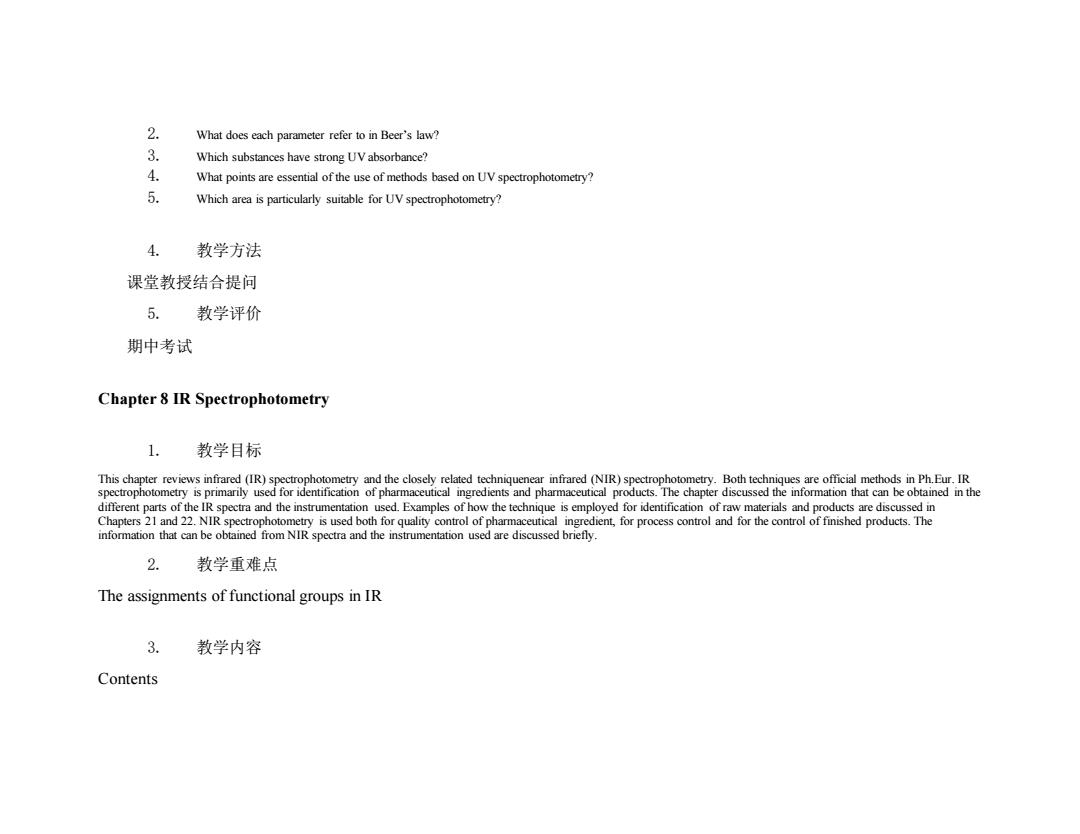
2. What does each parameter refer to in Beer's law? 3. Which substances have strong UV absorbance? 4. What points are essential of the use of methods based on UV spectrophotometry? 5. Which area is particularly suitable for UV spectrophotometry? 4. 教学方法 课堂教授结合提问 5. 教学评价 期中考试 Chapter 8 IR Spectrophotometry 1. 教学目标 This chapter reviews infrared(IR)spectrophotometry and the closely related techniquenear infrared (NIR)spectrophotometry.Both techniques are official methods in Ph.Eur.IR spectrophotometry is primarily used for identification of pharmaceutical ingredients and pharmaceutical products.The chapter discussed the information that can be obtained in the different parts of the IR spectra and the instrumentation used.Examples of how the technique is employed for identification of raw materials and products are discussed in Chapters 21 and 22.NIR spectrophotometry is used both for quality control of pharmaceutical ingredient,for process control and for the control of finished products.The information that can be obtained from NIR spectra and the instrumentation used are discussed briefly. 2. 教学重难点 The assignments of functional groups in IR 3. 教学内容 Contents
2. What does each parameter refer to in Beer’s law? 3. Which substances have strong UV absorbance? 4. What points are essential of the use of methods based on UV spectrophotometry? 5. Which area is particularly suitable for UV spectrophotometry? 4. 教学方法 课堂教授结合提问 5. 教学评价 期中考试 Chapter 8 IR Spectrophotometry 1. 教学目标 This chapter reviews infrared (IR) spectrophotometry and the closely related techniquenear infrared (NIR) spectrophotometry. Both techniques are official methods in Ph.Eur. IR spectrophotometry is primarily used for identification of pharmaceutical ingredients and pharmaceutical products. The chapter discussed the information that can be obtained in the different parts of the IR spectra and the instrumentation used. Examples of how the technique is employed for identification of raw materials and products are discussed in Chapters 21 and 22. NIR spectrophotometry is used both for quality control of pharmaceutical ingredient, for process control and for the control of finished products. The information that can be obtained from NIR spectra and the instrumentation used are discussed briefly. 2. 教学重难点 The assignments of functional groups in IR 3. 教学内容 Contents
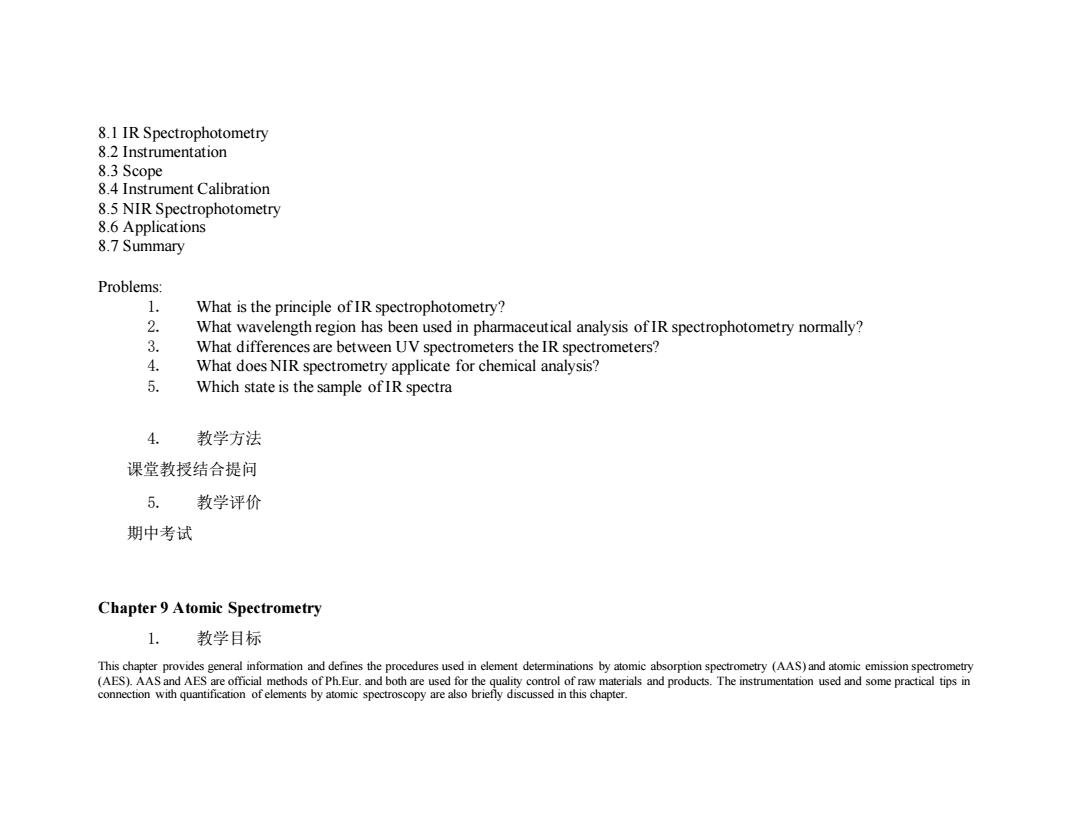
8.1 IR Spectrophotometry 8.2 Instrumentation 8.3 Scope 8.4 Instrument Calibration 8.5 NIR Spectrophotometry 8.6 Applications 8.7 Summary Problems: 1. What is the principle of IR spectrophotometry? 2. What wavelength region has been used in pharmaceutical analysis of IR spectrophotometry normally? 3. What differences are between UV spectrometers the IR spectrometers? 4. What does NIR spectrometry applicate for chemical analysis? 6 Which state is the sample of IR spectra 4. 教学方法 课堂教授结合提问 5. 教学评价 期中考试 Chapter 9 Atomic Spectrometry 1. 教学目标 This chapter provides general information and defines the procedures used in element determinations by atomic absorption spectrometry (AAS)and atomic emission spectrometry (AES).AAS and AES are official methods of Ph.Eur.and both are used for the quality control of raw materials and products.The instrumentation used and some practical tips in connection with quantification of elements by atomic spectroscopy are also briefly discussed in this chapter
8.1 IR Spectrophotometry 8.2 Instrumentation 8.3 Scope 8.4 Instrument Calibration 8.5 NIR Spectrophotometry 8.6 Applications 8.7 Summary Problems: 1. What is the principle of IR spectrophotometry? 2. What wavelength region has been used in pharmaceutical analysis of IR spectrophotometry normally? 3. What differences are between UV spectrometers the IR spectrometers? 4. What does NIR spectrometry applicate for chemical analysis? 5. Which state is the sample of IR spectra 4. 教学方法 课堂教授结合提问 5. 教学评价 期中考试 Chapter 9 Atomic Spectrometry 1. 教学目标 This chapter provides general information and defines the procedures used in element determinations by atomic absorption spectrometry (AAS) and atomic emission spectrometry (AES). AAS and AES are official methods of Ph.Eur. and both are used for the quality control of raw materials and products. The instrumentation used and some practical tips in connection with quantification of elements by atomic spectroscopy are also briefly discussed in this chapter